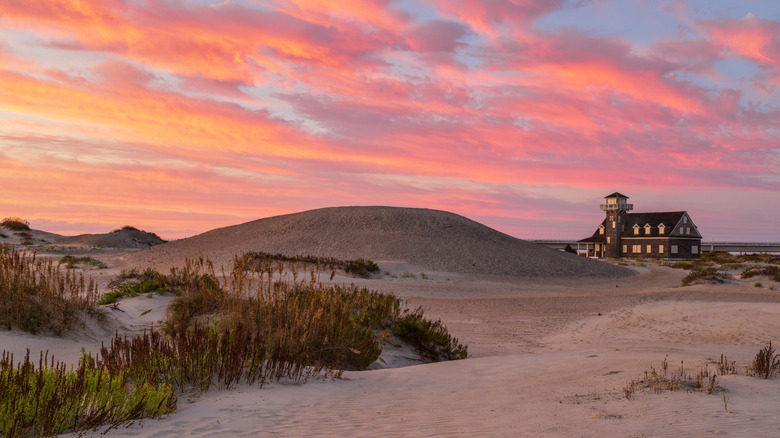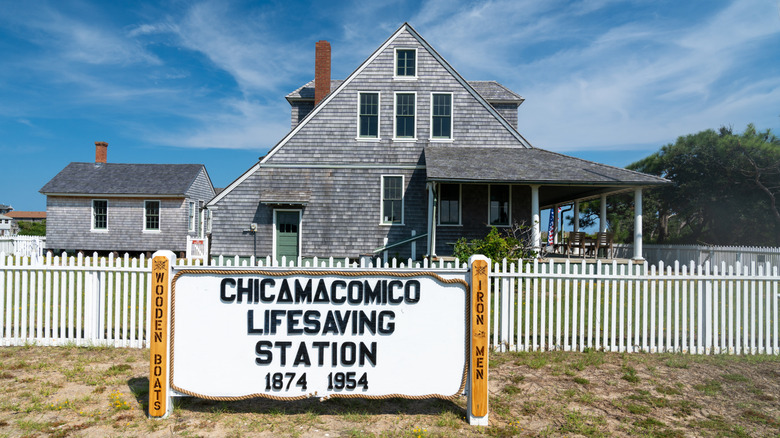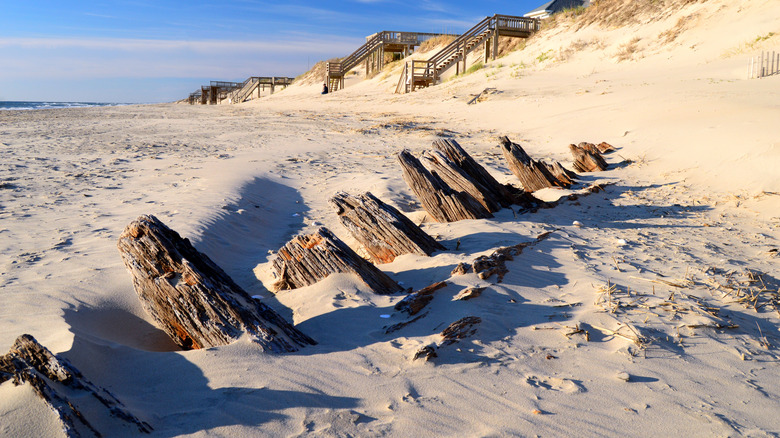One Of The Most Historic Maritime Sites On The East Coast Is A Unique Outer Banks Museum
Today, the Outer Banks are a mecca for sun-seeking tourists looking to escape mainland life. They're filled with chic North Carolina beach town getaways and dune-lined island adventures. But for as long as ships have plied the waters of the Atlantic, the area has had a far more ominous reputation. Called the Graveyard of the Atlantic for the thousands of vessels that have wrecked on the beaches and nearby shoals, the area is treacherous for mariners due to its shifting sands, bottom topography, and sudden severe weather.
In the 1800s, the U.S. government invested in protecting the ships passing the North Carolina coast. Many iconic lighthouses were built to warn mariners away, and Life-Saving Stations were built up and down the coast. The Life-Saving Service (LSS), along with the Revenue Cutter Service, were the precursors to the modern-day Coast Guard. The first outpost of the LSS on the Outer Banks was in Rodanthe, and the building still stands today as a museum and testament to the brave surfmen who staffed it over the years.
The Chicamacomico Life-Saving Station was built in 1874, the first of seven in the area constructed that year, followed by 11 more by the end of the decade. The museum has two original buildings that house the equipment used by the LSS for training, including an original surfboat. It's one of the most complete stations of its kind left in America, and wandering through the buildings and exhibits provides a glimpse into the lives of those who served here.
Stories of history and heroism at the Chicamacomico Life-Saving Station
The Outer Banks is a fitting location for one of the most complete and fascinating museums of the U.S. Life-Saving Service. Since the 1500s, there have been around 5,000 shipwrecks off this stretch of coast. Wrecks are so numerous here that storms often uncover wood beams and ship parts that have been forgotten, buried under the sand for decades. For more information on the area's history and shipwrecks, consider visiting the Graveyard of the Atlantic Museum in Hatteras Village, a beautiful small-town getaway just under an hour south of Rodanthe.
Chicamacomico's most famous rescue came in 1918 when 42 crew members from the British tanker Mirlo were rescued. A German U-boat had torpedoed the tanker just offshore. The surfboat and much of the equipment used during the heroic operation can be viewed at the museum today. Another daring rescue happened at the Gull Shoal Station in 1899 when a lone surfman encountered the wrecked barkentine Priscilla while patrolling the beach on horseback. Single-handedly, he rescued 10 victims in what is still considered one of the top 10 rescue operations in Coast Guard history.
The buildings at Chicamacomico are open for self-guided tours. If you're part of a group of 20 or more, you can schedule a guided group tour with two weeks advance notice. One of the highlights of visiting is seeing the reenactment of a Beach Apparatus Drill, which is performed every Thursday at 2 p.m. between Memorial and Labor Days. The drill simulates how crews would use a large gun to shoot a line out to a sinking ship. Using a block-and-tackle system, the line could then be used to move equipment and victims to the beach without putting the life-saving boats into dangerous conditions.
Planning your visit to Rodanthe and the Outer Banks
The Chicamacomico Life-Saving Station is open for visits from 10 a.m. to 5 p.m., Monday through Friday. Admission is good for a whole week; individual tickets are $10, or you can purchase a family pass for up to five people for $30 (at the time of this writing). Proceeds go directly to the non-profit that restores and preserves that facility. The station is closed for the Memorial, Independence, and Labor Day holidays.
The museum is located in the Outer Banks village of Rodanthe, North Carolina, right off State Highway 12. It's about halfway between Nags Head and Hatteras at milepost 39.5. Coming from the north, you'll arrive at the Outer Banks via U.S. Highway 158; coming from the west or south, you'll arrive on U.S.-64 through the town of Manteo, at the heart of Roanoke Island. From the Norfolk area, the drive takes a little over two hours, while it's about three and a half hours from Raleigh.
Tourist season on the Outer Banks happens during the summer when all the area's vacation rentals fill up with folks looking to get some beach time. But, outside of extreme weather events like summer hurricanes or winter nor'easters, the Life-Saving Station and the Outer Banks are open year-round. During spring, fall, and winter, you'll find cheaper rates on hotels and rentals, fewer crowds, and moderate temperatures — even winter daytime highs average in the 50s degrees Fahrenheit.


